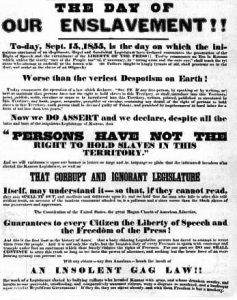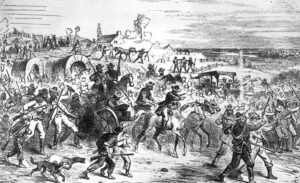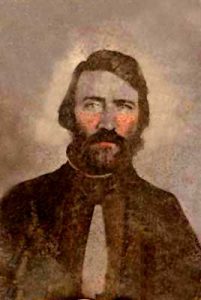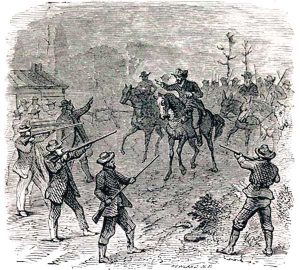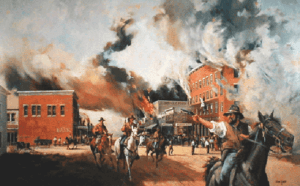The Free-State Plan. The Free-State people decided to ignore the pro-slavery government. Since the “Bogus Legislature made them outlaws,” they organized another government and sought the admission of Kansas as a state. To accomplish this, it was necessary to draw up a state constitution, which the people must approve of the Territory and Congress.
Free-State Leaders. Several meetings were held to get the Free-State people interested and willing to work together. The leaders in these efforts were Dr. Charles Robinson of Lawrence, ex-Governor Andrew Reeder, who had come back to Kansas as a tireless worker in the Free-State cause, and James H. Lane, a man of much experience, who had recently come to Kansas. Lane became one of the most radical Free-State men and played an essential part in Kansas affairs for many years. The Topeka Constitution, 1855. In the fall of 1855, a convention was held at Topeka, and a state constitution that said, “There shall be no slavery in this State,” was drawn up. When a little later, the Topeka Constitution was submitted to the people’s vote, it was carried by an immense majority. Only Free-State people voted, of course, for the pro-slavery people did not recognize any of these acts as having any force. Later in the winter, state officers were elected under the Constitution, Dr. Charles Robinson being made Governor and James H. Lane a United States Senator. In the spring of 1856, the Constitution was sent to Congress to request that Kansas be admitted to the Union, but the bill making Kansas a state failed to pass.
The Wakarusa War, 1855. These were not the only events occurring in the Territory. It had become evident early in the fall of 1855 that with the people divided into these two groups, each governing itself and denying the authority of the other, there would be a conflict. The pro-slavery people had committed several outrages that added to the irritation of the Free-State people, but the real trouble came with the murder of a Free-State man. This brought on what was called the Wakarusa War. The Beginning of the Trouble. A pro-slavery man named Coleman shot and killed a young Free-State man named Dow. This occurred about ten miles south of Lawrence. Coleman then fled to Westport, Missouri, where he appealed for protection to a man named Jones, who, although he lived in Missouri and was the postmaster at Westport, had been appointed by the “Bogus Legislature” as sheriff of Douglas County. Jones was a border ruffian of the lowest and most dangerous type and had made himself obnoxious to the Free-State people by his leadership in the fraudulent elections.
The Arrest of Branson. In the meantime, a friend of Coleman declared that his life was threatened by Jacob Branson, an old man with whom young Dow had made his home. Thereupon, Sheriff Samuel Jones arrested Branson, but a party of Free-State men, indignant because of such highhanded proceedings, rescued him and took him to Lawrence.
Hatred of Lawrence. Of all the settlements in Kansas, Lawrence was the most hated by the pro-slavery people, for it was the hotbed of Free-State principles and the gathering place of those who scorned the Territorial Legislature. There had come to be a general pro-slavery conviction that nothing less than the destruction of this town could bring them peace and safety.
Sheriff Jones Gathers an Army. Lawrence had nothing to do with this trouble with the sheriff, but when the rescued Branson was taken there, it gave the enemy an excuse to threaten the town’s destruction. When his prisoner was taken from him, Jones sent a call to Missouri for help and asked Governor Wilson Shannon for 3,000 men to “carry out the laws.” The result was that fifteen hundred Missourians assembled for the destruction of Lawrence and camped on the banks of the Wakarusa River about three miles south of the town.
Lawrence Prepares for Defense. Meanwhile, although Branson and his rescuers had left Lawrence and there was not a man in the town for whom Jones had a warrant, his army continued to gather, and Lawrence prepared for defense. The surrounding settlers came in, and the 600 men built fortifications and drilled.
End of the Wakarusa War. The army of Jones, an “unwashed, braggart, volcanic multitude,” was living off the surrounding country, rifling cabins and stealing horses and cattle. The people of Lawrence were also feeling the burden of the siege, for with the large number of those who had come in from the outside, their supplies were rapidly exhausted. Finally, two men succeeded in getting through the enemy’s lines and reaching the Governor, who was being deceived about conditions. Governor Shannon then came to Lawrence and, learning how things really were, took an active part in arranging a treaty between the opposing forces and, to the disgust and disappointment of Sheriff Jones, dispersed the pro-slavery army. Without battle or bloodshed, what has since been known as the Wakarusa War was over.
Summary. Instead of submitting to the pro-slavery Territorial Government, the Free-State people set up another government. They held a convention at Topeka and drew up a constitution prohibiting slavery. The Free-State people of the Territory adopted this constitution and then sent it to Congress to request that Kansas be admitted to the Union. The bill failed to pass. These rival governments within the Territory brought on the Wakarusa War, the principal events of which were as follows: Coleman shot Dow and fled to Jones, sheriff of Douglas County, for protection. Jones arrested Dow’s friend Branson, who was rescued by Free-State men and taken to Lawrence, the town most hated by the pro-slavery people. Jones then gathered an army of Missourians to destroy Lawrence. While both sides were preparing for the struggle, two Free-State men reached Governor Shannon, who came to Lawrence. On learning the actual condition, they arranged a peace treaty and dispersed the pro-slavery army.
Compiled & edited by Kathy Alexander/Legends of America, updated January 2023. Source: Arnold, Anna E.; The State of Kansas; Imri Zumwalt, state printer, Topeka, Kansas, 1919.
Also See:
Bleeding Kansas & the Missouri Border War

